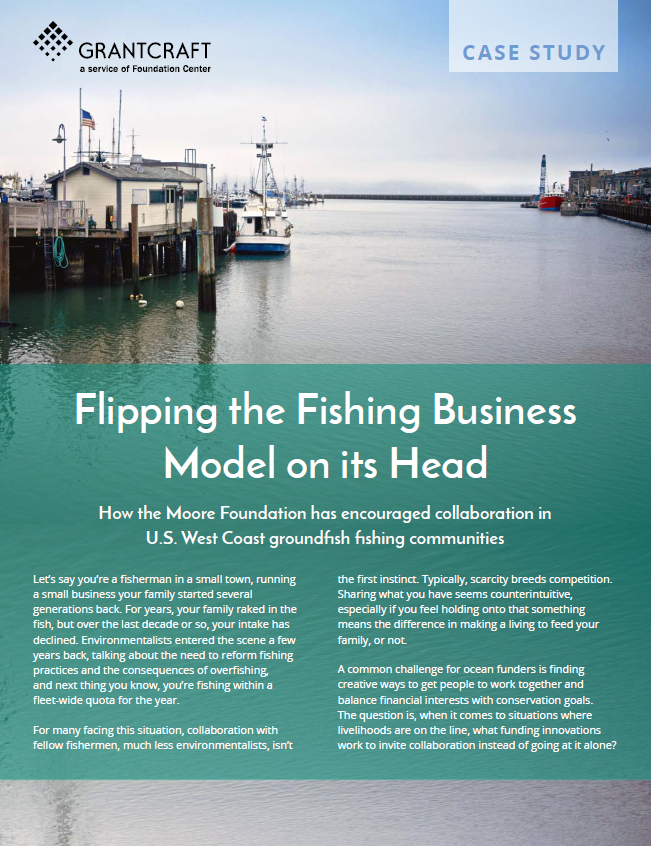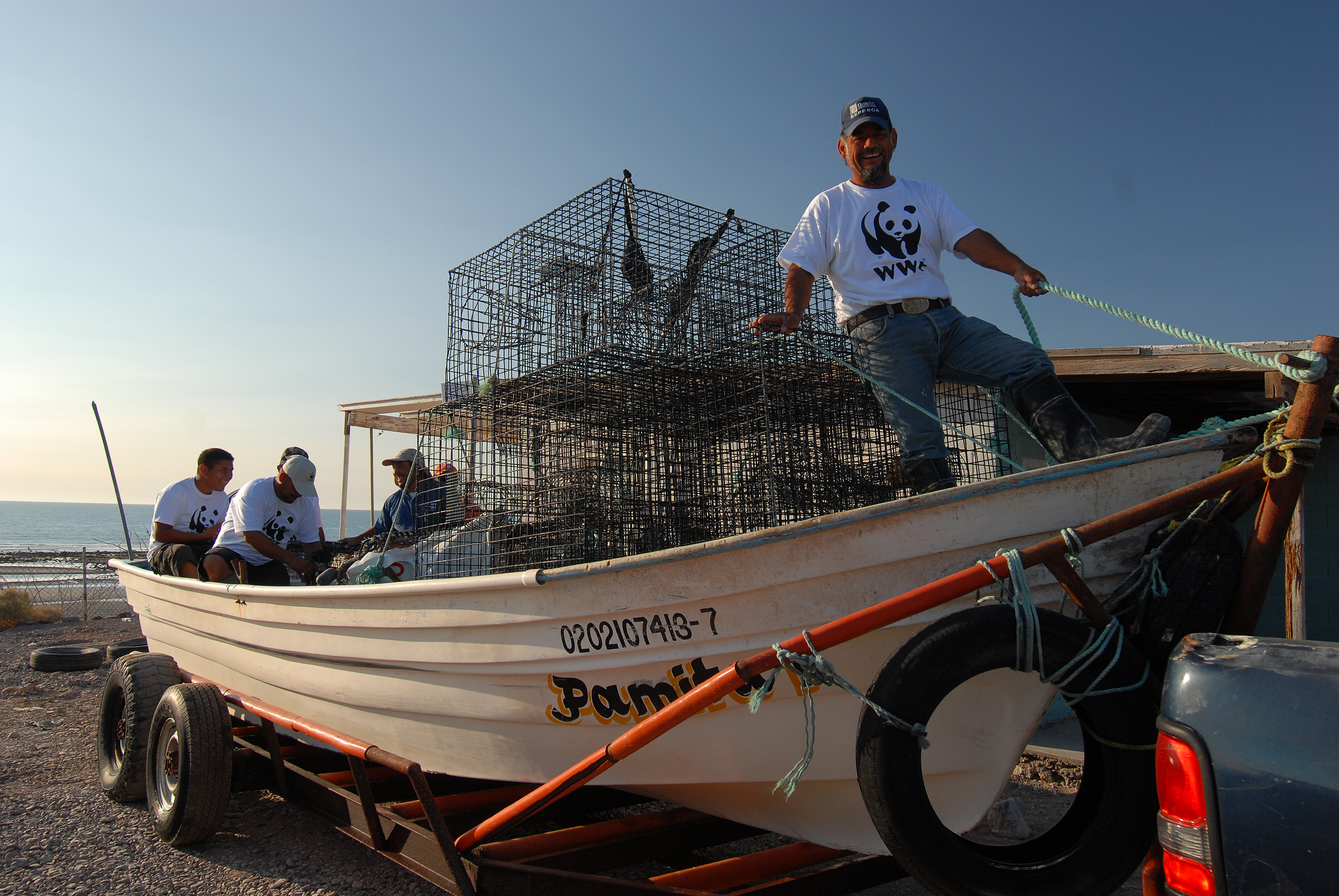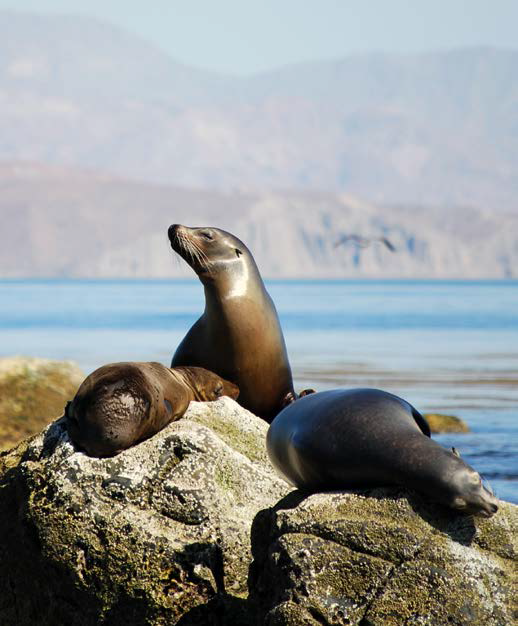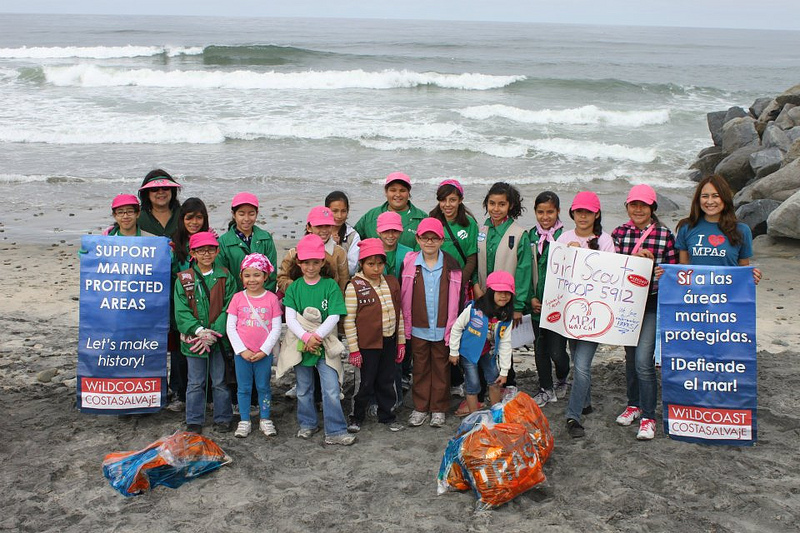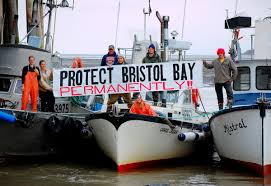Flipping the Fishing Business Model on its Head How the Moore Foundation encouraged collaboration
Let’s say you’re a fisherman in a small town, running a small business your family started several generations back. For years, your family raked in the fish, but over the last decade or so, your intake has declined. Environmentalists entered the scene a few years back, talking about the need to reform fishing practices and the consequences of overfishing, and next thing you know, you’re fishing within a fleet-wide quota for the year.
For many facing this situation, collaboration with fellow fishermen, much less environmentalists, isn’t the first instinct. Typically, scarcity breeds competition. Sharing what you have seems counterintuitive, especially if you feel holding onto that something means the difference in making a living to feed your family, or not.
A common challenge for ocean funders is finding creative ways to get people to work together and balance financial interests with conservation goals. The question is, when it comes to situations where livelihoods are on the line, what funding innovations work to invite collaboration instead of going at it alone?
At the Gordon and Betty Moore Foundation, whose mission is to foster path-breaking scientific discovery, environmental conservation, patient care improvements, and preservation of the Bay Area’s character, supporting ocean innovation that encourages collaboration rather than further entrenching folks in isolation represents core work. Whether it’s by bringing constituencies across place-based communities together for planning, or reforming fishery management systems so that both jobs and fisheries are sustainable, Moore’s approach helps community stakeholders refocus their sights on long-term gains versus short-term profits.
Here’s how Moore partnered with The Nature Conservancy to work toward collaborative versus competitive outcomes with groundfish fishing communities on the West Coast of the U.S.
For more than a decade, Moore has supported groundfish management reform in the U.S. through its Marine Conservation Initiative. Groundfish are species that live on or near the bottom of the ocean. They include 90-plus species that fall into one of the following categories: rockfish, flatfish, roundfish, sharks and skates, and other species. In certain regions, like the U.S. West Coast, the groundfish industry has suffered major setbacks. The domino effect of fish population declines constricting catch limits had led to high levels of unemployment, underemployment and fishermen leaving the industry, with many in need of public assistance or retraining for other jobs. For the West Coast groundfish fishery, the circumstances became so dire it was declared a federal economic disaster in 2000.
Before working together, both Moore and The Nature Conservancy took steps individually that made their later groundfish fishery reform partnership successful. In the mid-2000’s, The Nature Conservancy partnered with fishermen in a habitat protection plan that made it the second largest groundfish fishing rights holder on the West Coast. Moore had been advocating for groundfish management reform, pushing for the use of a catch share system (basically, a fishing quota system that ensures the sustainable harvesting of fish).
“We came together at an interesting time,” says Michael Bell, director of the ocean program for The Nature Conservancy in California. “Some fishing communities felt reluctance, to put it mildly, about moving toward a catch share program.” Here’s why: catch share programs allocate fishing rights to individuals that are transferable. That means transfers happen when some fishermen choose to sell their privileges to someone else. This can result in a high degree of consolidation in fisheries. “The big fish buy out the small fish, essentially,” he says. If all the fishermen in a small fishing community sell their shares, that can leave that fishing community without access to fishing grounds they’ve always depended on because of private transactions between fishermen. “The mayor of a port community who knows nothing about these transactions all-of-a-sudden no longer sees fish coming in the local dock. This has implications for the rest of the local economy, not to mention the social fabric of that town.”
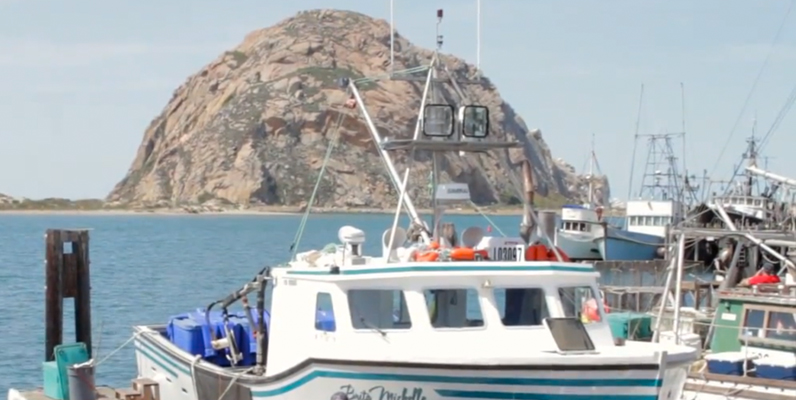 Why might smaller fishing operations sell out to larger ones? A catch share program, which establishes a total quota for a fishery and then gives individual fisherman an amount of each type of fish they’re allowed to catch for a year, typically represents more costs to fishermen in return for much greater flexibility in how they run their operations. For example, fishermen must account for their catch, so they may have to pay for an observer onboard, but they can harvest their fishing rights whenever they like over the course of the year. This yields economic benefits to fishermen (being in control of their harvest plan) and environmental benefits (much better information on what’s being caught). The rub: to be successful fishermen must be able to pay more and manage a more flexible, complex business. That means operations with access to capital, an established market, and experience in business growth often buyout quota from those operations lacking those attributes. The buyers usually come from the larger ports and the sellers from smaller ports.
Why might smaller fishing operations sell out to larger ones? A catch share program, which establishes a total quota for a fishery and then gives individual fisherman an amount of each type of fish they’re allowed to catch for a year, typically represents more costs to fishermen in return for much greater flexibility in how they run their operations. For example, fishermen must account for their catch, so they may have to pay for an observer onboard, but they can harvest their fishing rights whenever they like over the course of the year. This yields economic benefits to fishermen (being in control of their harvest plan) and environmental benefits (much better information on what’s being caught). The rub: to be successful fishermen must be able to pay more and manage a more flexible, complex business. That means operations with access to capital, an established market, and experience in business growth often buyout quota from those operations lacking those attributes. The buyers usually come from the larger ports and the sellers from smaller ports.
But there are ways to address these challenges. Fishermen from smaller fishing ports can organize to achieve the same scale advantages available to larger fishing operations. Despite these potential challenges, catch shares have proven to be a successful tool for shifting fisheries from a race to catch as many fish as possible toward more sustainable fishing practices that economically benefit fishermen. Moore wanted to give communities the opportunity to experience the benefits firsthand. As a stakeholder with a track record of working with industry, communities, and now a major asset holder in the fishery, Moore recognized that The Nature Conservancy was well positioned to step in. “They were helping communities organize and innovate ways of managing fishing rights locally to address these challenges,” says Rachel Strader, program officer in the Marine Conservation Initiative at the Moore Foundation. Moore funded The Nature Conservancy to continue its work in Morro Bay, a community where local fishermen had been struggling for several decades. Funding brought together a group of fishermen to experiment with fishing under a shared quota.
After some experimentation, The Nature Conservancy learned the lack of access to information was a big barrier to collaboration and breaking down traditional ways of doing business. “In the past fishermen hoarded information, competing with each other constantly,” says Michael. “They didn’t want to share if they had bad trips or good trips or anything because they didn’t want to give away their ‘honey holes.’” Once fishermen started fishing under a shared quota, where each got a share of the total quota that they could individually profit from, there was an opportunity to share data, which could benefit everyone. “We started sticking data up on our office wall about who was catching what, where,” says Michael. “We realized if we could address the data issue more strategically, we could accelerate learning and come up with adaptive innovative local models for fishery operations. All while dealing with this overfished species problem.”
That’s when the idea for eCatch, an online fisheries logbook, emerged. “We realized we needed to get faster and better at sharing this information between fishermen and scientists working on this experiment,” says Michael. Existing data systems managed by government haven’t allowed fishermen access to data in real time. Traditionally, years after submitting data, fishermen get it back along with a bunch of new regulations. “And people have wondered why fishermen are so angry and have tried to cheat the system,” says Michael.
The eCatch software provides an easy and low-cost way for fishermen to directly collect, map and share their fishing information in a private and secure manner. Fishermen can collect information via devices like notepads and mobile phones. Since it’s web-based, the information is immediately accessible and goes into the mapping system. “Having access to this data has helped make the catch share system work better for participating fishermen,” says Rachel. It has helped them independently collect and share information on where and what kind of fish they are catching so that they can avoid areas of high bycatch or where there are species they don’t want to catch. “Anyone, be it scientist or fisherman, can log in and see what’s happening at any moment,” says Michael.
As eCatch got up and running, the West Coast groundfish fishery completed the design of a catch share program. Fishermen across the West Coast groundfish industry were now required to participate. That’s when The Nature Conservancy, with Moore funding, worked with community leaders in Morro Bay, Half Moon Bay, and Fort Bragg to create risk pools. Leaders from these communities set up a membership association called the California Groundfish Collective through which they now run the pool. Members pool their overfished species quota and The Nature Conservancy, because it holds assets in the fishery, has put its overfished species quota in to fatten the pool. That incentivizes membership in the association and participation in the pool. “It’s an insurance mechanism,” says Rachel. “If members from these port communities now accidentally catch overfished species, they’re covered through the pool.”
To become a member of the risk pool, fishermen must develop sustainable fishing plans using eCatch data so that they’re helping manage risk within the pool. “This creates a built-in enforcement mechanism,” says Michael. “You might call it fisherman peer pressure. If you’re one port community, you want members in another port community using this technology and capturing the best data possible to develop sustainable fishing plans. That means the entire risk pool is incentivized to work together and improve conservation practices in the region.”
According to Moore and The Nature Conservancy, a change in mindset within the fishing communities gave rise to innovation well beyond these examples. “We witnessed a breakthrough,” says Michael. “Fishermen started saying, ‘we can’t keep running this industry based on scarce natural resources by just competing with each other.’”
Incentivizing collective participation into robust, real time, data collection has contributed to this mindset shift, as has developing models whereby local stakeholders now play a much larger role in management. This has transformed the fishery management paradigm from one which is traditionally centralized and rigid, to one where private sectors and local stakeholders now help set performance standards and then innovate to meet them.
There’s still work ahead on fishery monitoring, data collection, and helping fishermen gain access to new markets because of their conservation gains. But for Moore, its West Coast groundfish management reform efforts to-date represent a solid investment. “Whenever we propose a new funding initiative or program we ask: is it important, can we make a difference on the issue, is it measurable and will investing in it enable us to have a portfolio effect,” says Rachel. “When it came to investing in the West Coast groundfish fishery, which was in bad shape, we felt the answers to those questions were ‘yes’ across the board. Now that fishery has become more stable and is also a model for effective fishery management. It’s gone from being declared a federal economic disaster in 2000 to one where most of the fish are certified as sustainably harvested.”
The Nature Conservancy, also with Moore support, is now taking what it has learned and developed to benefit projects around the world. “We wouldn’t be in this position without Moore support,” says Michael. “Its program staff really got involved and grabbed hold of certain issues that could have gotten in the way.” For example, as The Nature Conservancy built eCatch, it knew that ultimately what it created needed to be integrated into federal data management systems. The challenge is that these government systems are seriously antiquated. Moore has played an important role in diagnosing the problems associated with these systems and funding their upgrade. Moore has also played an important role as a connector. “Whether it was with other groups on the West Coast or other fisheries elsewhere, like the groundfish fishery in New England, program staff established connections that made our efforts more effective,” says Michael.
Indeed, Moore and The Nature Conservancy’s commitment to relationship building has helped change hearts and minds. Groundfish fishing communities on the U.S. West Coast have now seen firsthand how the bottom line for their fisheries, as well as for individual fisherman, improves when people work together.
What’s next for Moore with West Coast groundfish fishing management reform? “Our work is in a transition phase where we are ramping down our support,” says Rachel. “In the next couple of years, our work with The Nature Conservancy and our other grantees will focus on maintaining conservation gains, while making sure that there are strong fishing businesses. A big focus is ensuring that monitoring and accountability in the fishery is effective and less costly. We’re also supporting efforts to ensure strong leadership in fishing communities into the future."
This case study was developed as a companion piece to stories shared through Foundation Center’s Funding the Ocean project. Funding the Ocean is a dynamic hub to inform and inspire ocean conservation philanthropy around the world. It includes a mapping application, repository of reports and case studies, and a cloud-based platform for engagement.
